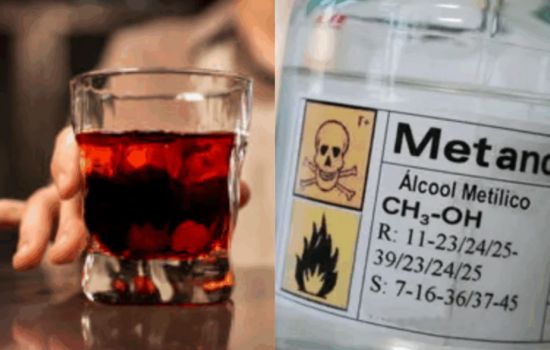In 2025, the world witnessed a growing problem related to the consumption of beverages adulterated with methanol, a highly toxic compound that has caused serious consequences in several regions of the planet.
Google News – Daily Headlines
★ 4.0Information on size, installation and warranty may vary as updates are made in official stores.
Methanol, often used illegally to increase the volume of alcoholic beverages and reduce costs, has caused mass poisonings, deaths, and a public health crisis in several countries.
This phenomenon has raised global concerns about the safety of alcohol production and consumption, as well as the need to implement stricter measures to prevent these types of tragedies.
In this article, we'll explore the locations most affected by this problem, the measures being taken to address it, and the lessons that can be learned to prevent future incidents.
Introduction
Methanol is a type of industrial alcohol used in a variety of applications, such as the manufacture of fuels, solvents, and chemicals.
However, its use in alcoholic beverages is extremely dangerous and can have lethal consequences.
Despite strict regulations in many countries, methanol continues to be a problem in several regions of the world due to its illicit use in the manufacture of low-cost alcoholic beverages.
Throughout 2025, several countries have witnessed outbreaks of mass poisonings due to the consumption of methanol-contaminated beverages, highlighting the deficiencies in the oversight and control of alcohol production in many parts of the world.
As cases of poisoning increase, health authorities have stepped up investigations and measures to prevent the spread of this scourge, but significant challenges remain. It is critical to understand the impact that methanol in beverages has had in various regions and how these crises are being managed to prevent future cases.
Content Development
1. Cases of Methanol Poisoning in the World
Throughout 2025, several countries have faced significant outbreaks of methanol poisoning due to the adulteration of alcoholic beverages. The effects of methanol are devastating, as it can cause brain damage, blindness, kidney failure, and even death. Below are some of the countries most affected by this crisis.
Asia: A Persistent Problem
In many Asian countries, the consumption of alcohol adulterated with methanol has been a recurring problem. Some of the most affected countries in 2025 include:
- IndiaIn northern India, particularly in the state of Uttar Pradesh, more than 100 deaths have been reported related to the consumption of alcoholic beverages contaminated with methanol. This outbreak has highlighted the lack of control over alcohol manufacturing in rural areas, where beverages are produced illegally to avoid taxes.
- IndonesiaIndonesia has experienced a series of methanol-related incidents in 2025, particularly in Bali and other tourist regions. Methanol has been found in alcoholic beverages sold in unregulated markets, resulting in deaths and hospitalizations. Authorities have stepped up inspections, but illegal sales remain a challenge.
- ChinaDespite efforts to eradicate the problem of methanol in alcoholic beverages, China remains a hotspot. In 2025, several provinces reported mass poisonings due to the sale of adulterated alcohol. In some cases, methanol was used as a substitute for ethanol, exacerbating the risk of poisoning.
Europe: Impact on Tourism and the Economy
In Europe, although controls on alcoholic beverage production are stricter, methanol remains a problem, especially in Eastern European countries. In 2025, the following cases stood out:
- Czech RepublicIn the Czech Republic, a country known for its beer and spirits production, methanol has affected tourists who purchased alcohol at unregulated markets. The outbreak of poisonings in Prague and other tourist cities raised concerns about the safety of international visitors.
- BulgariaIn Bulgaria, several serious incidents of methanol poisoning in 2025 affected the local population and tourists. Methanol was found in vodka and other traditional drinks, prompting authorities to intervene to destroy large quantities of adulterated alcohol.
Latin America: The Challenge of Regulation
In Latin America, the problem of methanol in alcoholic beverages has been present for many years, but in 2025, several countries faced major outbreaks:
- MexicoIn Mexico, where artisanal alcohol production is common, methanol has caused numerous deaths in the state of Veracruz. In 2025, the Mexican government implemented a series of operations to destroy batches of contaminated alcohol, but the problem remains persistent in rural and marginalized areas.
- ColombiaColombia has been another country affected by methanol in alcoholic beverages, especially in the south, where consumption of illegal liquor has increased. In 2025, multiple cases of poisoning were reported, putting health authorities on alert.
- ArgentinaIn Argentina, the sale of adulterated alcoholic beverages has also raised concerns. In 2025, several cases of poisoning were reported in provinces such as Mendoza, where it was discovered that methanol was being used in the production of wine and other low-cost alcoholic beverages.
Brazil: A Country Affected by Illegal Beverage Sales
In Brazil, beverage adulteration with methanol has been a growing problem in 2025. Despite government efforts to curb the production and distribution of illegal alcohol, poisonings continue to affect various regions of the country. In the state of São PauloMultiple deaths have been reported, especially in rural and suburban areas, due to the consumption of adulterated beverages. In some cases, methanol was used to cut traditional drinks like cachaça and vodka, leading to a series of poisonings and hospitalizations.
In addition, in Minas Gerais and PernambucoIn 2025, methanol was discovered to be used in the production of low-cost liquor. Throughout 2025, Brazilian authorities intensified operations to control and destroy these adulterated products, but illegal alcohol sales remain a significant challenge in many areas of the country.
2. Causes and Contributing Factors
The use of methanol in alcoholic beverages is not a recent phenomenon. However, several factors have contributed to its prevalence in 2025. The most important factors include:
- Lack of regulation in informal marketsIn many developing countries, illegal alcoholic beverages are produced in informal markets where authorities have no oversight. This facilitates the use of methanol as a substitute for ethanol due to its lower cost.
- Economic inequality and povertyIn regions with high poverty rates, the production and sale of adulterated alcohol has become a means of economic survival. Methanol, being much cheaper than ethanol, has been used to produce low-cost alcoholic beverages that can be sold at lower prices.
- Lack of education about the risks of methanolIn many regions, the population is insufficiently informed about the dangers of methanol. This has led many people to consume adulterated alcohol without realizing the potentially lethal consequences.
- Corruption and lack of government controlIn some countries, corruption has prevented the effective implementation of regulations on alcohol production and sales. This has allowed methanol to continue being used illegally in the manufacture of alcoholic beverages.
3. Measures to Combat the Problem
Several countries have implemented measures to mitigate the risk of methanol poisoning, although much remains to be done. Some of the key actions include:
- Improvement in quality controlsAuthorities have begun implementing stricter controls on the production of alcoholic beverages, conducting regular inspections of factories and markets.
- Awareness campaignsCampaigns have been launched to educate the public about the dangers of methanol and how to identify potentially adulterated beverages. These campaigns have focused on the most affected areas.
- Destruction of adulterated alcoholIn several countries, operations have been carried out to destroy large quantities of contaminated alcohol. These efforts aim to prevent adulterated alcohol from reaching consumers.
- Strengthening laws against illegal productionSome governments have implemented stricter laws to punish those who produce or sell adulterated alcohol. These laws include harsher penalties for those responsible for methanol poisoning.
Conclusion
The use of methanol in alcoholic beverages remains a serious problem in many parts of the world. In 2025, several countries experienced outbreaks of mass poisonings that caused numerous deaths and hospitalizations, including significant cases in Brazil. The causes of this phenomenon are diverse, but a lack of regulation, poverty, and corruption are key factors that allow methanol to continue being used in the production of illegal alcohol. Although measures are being taken to combat this problem, much remains to be done to eradicate the sale of adulterated beverages and protect consumer health. Education, regulation, and international cooperation are essential to ensure the safety of alcoholic beverages and prevent future tragedies.







